The term “Lavender Menace” was first summoned by Betty Friedan, storied author of “The Feminine Mystique” and a National Organization for Women spokesperson who feared the encroachment of lesbian feminists into what was then a very white, very heterosexual and very (upper-to-) middle-class second wave feminist movement. Lesbians would ruin everything, she feared, with their radical agenda and reputation for misandry!
Lesbian writer and activist Rita Mae Brown (author of Rubyfruit Jungle) promptly resigned from her post in NOW, and began planning a “Lavender Menace Zap” for the 1970 Second Congress to Unite Women in New York. Brown and her local lesbian radical feminist consciousness-raising group prepared a ten-paragraph “Women-Identified Women” manifesto and also hand-dyed and screenprinted “Lavender Menace” t-shirts for everybody, which they cleverly layered to obscure before filing into the 300-strong auditorium where the Congress was set to begin. But just as the first speaker came to the mic, a lesbian feminist switched off the lights, pulled the plug on the mike, and ignited a series of “rebel yells.” The lesbians tore off their coats and sweaters, revealing the shirts benath, and when the lights came back on, they were standing proud, yelling things like “I’m tired of being in the closet because of the women’s movement!” and ‘Who wants to join us?” The Menaces passed out copies of “The Women-Identified Women” and stole a few minutes of stage time to address the exclusion of lesbians from the conference and the women’s movement. By the second day of the congress, lesbians were running workshops on homophobia. It was a major turning point for lesbian inclusion in mainstream feminism.
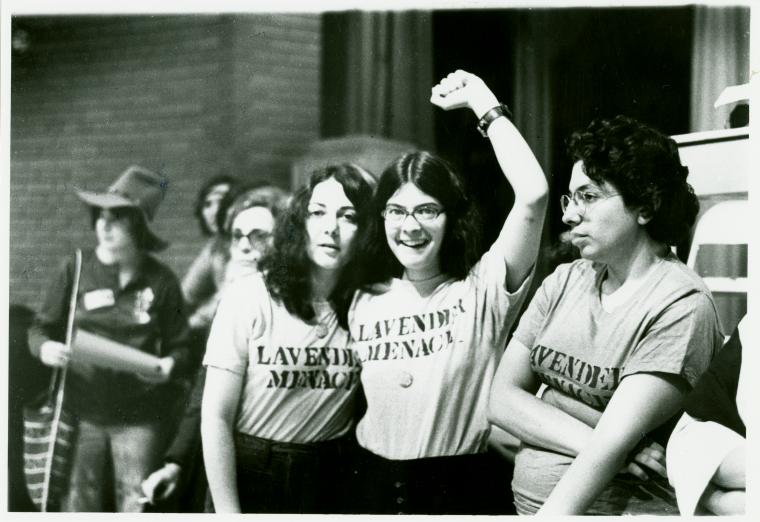
Three members of Lavender Menace at the Second Congress to Unite Women, New York, 1970 May (May 1970), photo by Diana Davies via NYPL
That zap was re-located to a different event and a different time with different participants for the 2017 LGBT history miniseries “When We Rise,” which inspired us to make Lavender Menace t-shirts for y’all. They were a HIT and we’ve blown through five printings of each cut, all proudly donned by lesbians, queers, bisexuals, pansexuals and otherwise-identified women and non-binary people who look good in purple. (Which is truly everybody.)
The spirit of our Lavender Menace shirt is the spirit of all of us here, who flaunt the heteronormative patriarchy and dare to be ourselves, even when it pisses everybody else off and even when it’s not politically convenient.
Vintage Lesbian Feminist Classics

1. Sappho Was a Right-On Woman by Sidney Abbott ($1.99), 2. Chicana Lesbians: The Girls Our Mothers Warned Us About, edited by Carla Trujillo ($9.25), 3. Lesbian Nation: The Feminist Solution, by Jill Johnston ($25.71), 4. Lesbian Ethics: Toward New Values, by Sarah Lucia Hoagland ($2.50), 5. Lesbian/Woman, by Del Martin & Phyllis Lyon ($3), 6. Twice Blessed: On Being Lesbian, Gay and Jewish, by Christie Balka and Andy Rose ($6.05), 7. This Bridge Called My Back, Fourth Edition: Writings by Radical Women of Color, edited by Cherríe Moraga and Gloria Anzaldúa ($19.97), 8. Black Lesbian in White America, by Anita Cornwell ($45), 9. Lesbian Culture: An Anthology : The Lives, Work, Ideas, Art and Visions of Lesbians Past and Present, Julia Penelope, Susan J. Wolfe ($3)
Things have changed a lot since lesbian feminism’s heyday and a lot of the ideas central to lesbian feminist thinking have been rejected by contemporary LGBT women’s communities — like its frequent exclusion of trans and bi women and its habitual opposition to BDSM, sex work, porn and butch/femme roles. Other principles remain for those who are still committed to many of its separatist ideologies, like creating self-sustaining societies entirely independent from men. Others have been built upon by queer theory and contemporary queer communities that include lesbian, bisexual, queer and trans women and often non-binary people, like questioning heteronormativity, valuing female solidarity, defying traditional gender roles and low-key separatism. A former member of the Lesbian Avengers told me once that radical political ideas serve an important function on many levels — through considering the radical, we’re able to more clearly identify the realistic.
Sappho Was a Right-On Woman is considered the first nonfiction book about lesbianism from a “positive perspective.” This Bridge Called My Back is a landmark anthology of Chicana lesbian feminism, which came out of the 70s/80s Chicana feminism movement and aimed to create what Chicana lesbians Cherie Moraga and Gloria Anzaldúa called “theory in the flesh,” “one where the typical realities of our lives —our skin color, the land or concrete we grew up on, our sexual belongings—all fuse to create a political born out of necessity.”
These books are great gifts for people who can understand them in context.
Books That Look Back On Lesbian Feminism
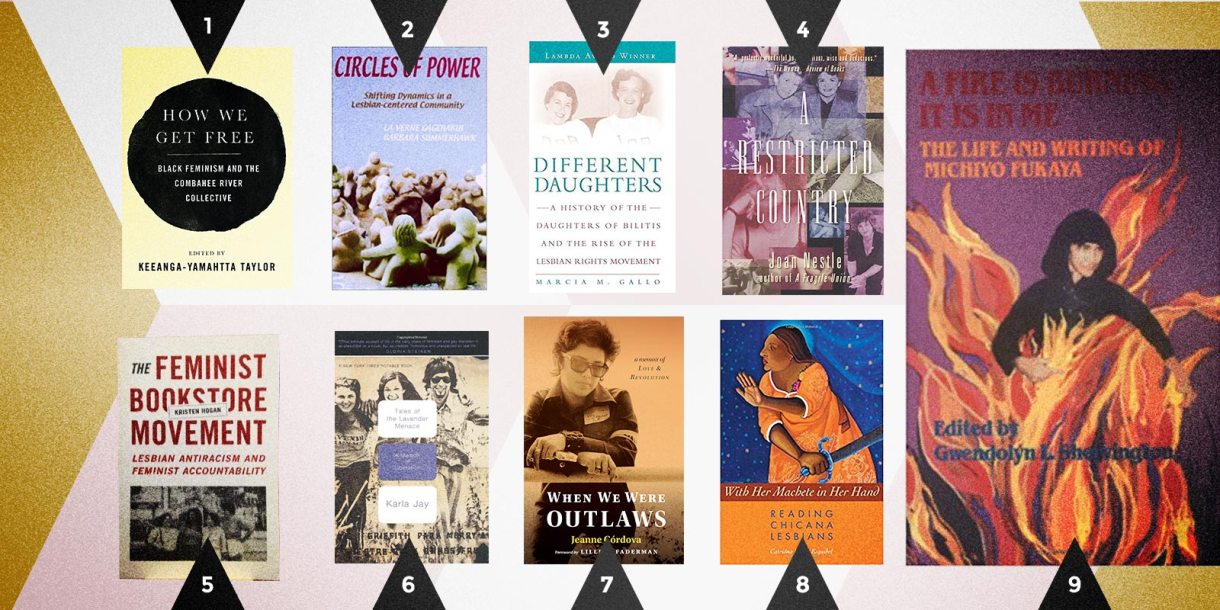
1. How We Get Free: Black Feminism and the Combahee River Collective, edited by Keenaga-Yamahtta Taylor ($13.23), 2. Circles of Power: Shifting Dynamics in a Lesbian-Centered Community, by Laverne Gagehabib & Barbara Summerhawk ($10.32), 3. Different Daughters: A History of the Daughters of Bilitis and the Rise of the Lesbian Rights Movement, by Marcia M. Gallo ($17), 4. A Restricted Country, by Joan Nestle ($19.95), 5. The Feminist Bookstore Movement: Lesbian Antiracism and Feminist Accountability, by Kristen Hogan ($20.50), 6. Tales of the Lavender Menace, by Karla Jay ($10.87), 7. When We Were Outlaws, by Jeanne Cordova ($10.63), 8. With Her Machete In Her Hand: Reading Chicana Lesbians, by Catriona Rueda Esquibel ($14.29), 9. A Fire Is Burning It Is in Me: The Life and Writings of Michiyo Fukaya, by Michiyo Fukaya and Gwendolyn L. Shervington ($9)
These books look back on the emerging lesbian rights movement, either through a historical/political lens or through memoir and personal experience.
Books That Look Ahead: Inclusive Lesbian and Queer Voices
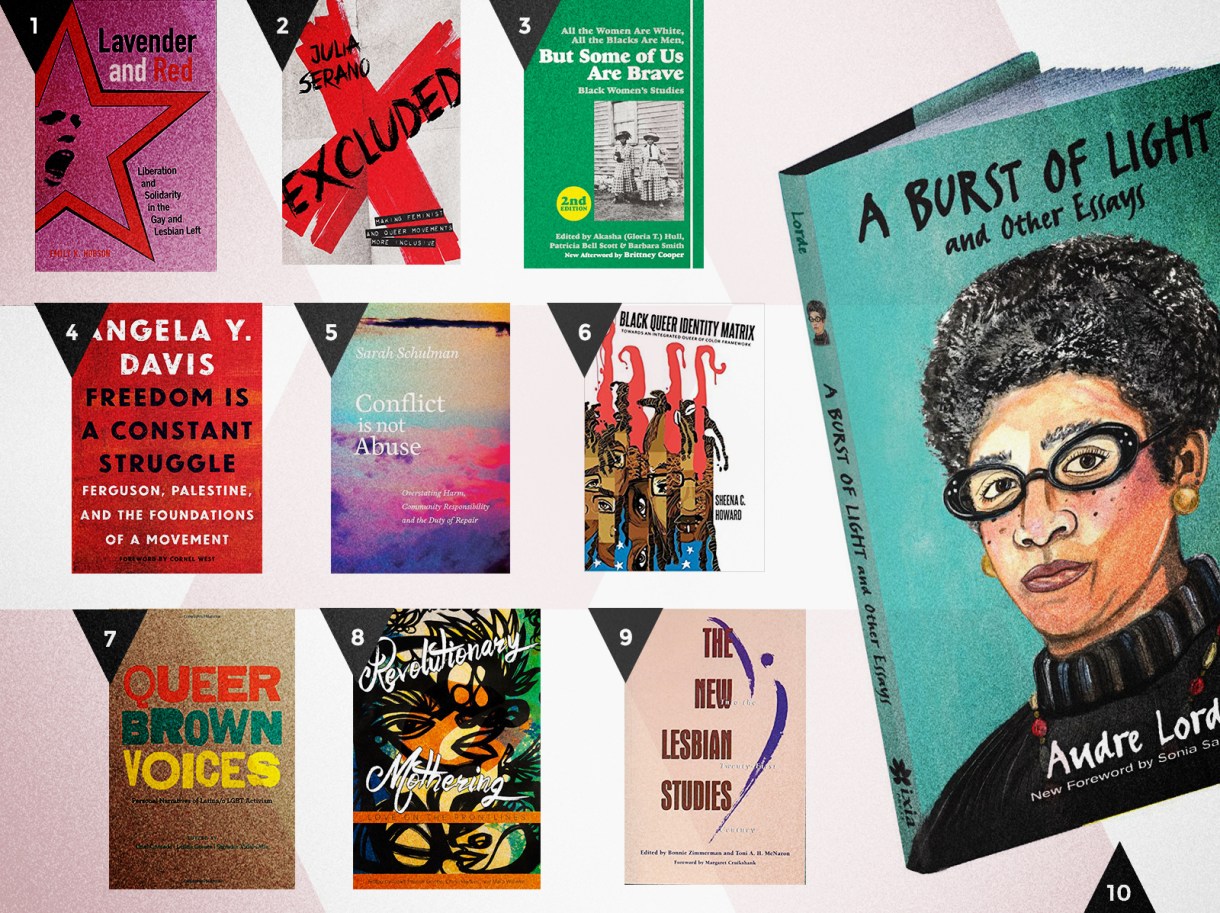
1. Lavender and Red: Liberation and Solidarity in the Gay and Lesbian Left, by Emily K. Hobson ($29.95), 2. Excluded: Making Feminist and Queer Movements More Inclusive, by Julia Serano ($15.46), 3. But Some Of Us Are Brave: Black Women’s Studies, by Akasha (Gloria T.) Hull, Patricia Bell Scott and Barbara Smith ($18.95), 4. Freedom is a Constant Struggle: Ferguson, Palestine, and the Foundations Of A Movement, by Angela Y. Davis ($10.84), 5. Conflict is Not Abuse: Overstating Harm, Community Responsbility and the Duty of Repair, by Sarah Schulman ($13.56), 6. Black Queer Identity Matrix: Toward an Integrated Queer of Color Framework ($29.95), 7. Queer Brown Voices, by Uriel Quesada and Letitia Gomez ($24.95), 8. Revolutionary Mothering: Love on the Front Lines, by Alexis Pauline Gumbs, China Martens, Mai’a Williams and Loretta J Ross ($12.20), 9. The New Lesbian Studies, by Bonnie Zimmerman, Toni A.H. McNaron & Margaret Cruikshank ($16.15), 10. A Burst of Light: And Other Essays, by Audre Lorde ($15.28)
Smart women and otherwise identified-queers and trans folks with big ideas for the issues facing us now and forevermore. I will not rest until everybody reads Conflict is Not Abuse, sorry.
Lesbian Clothing / Accessories
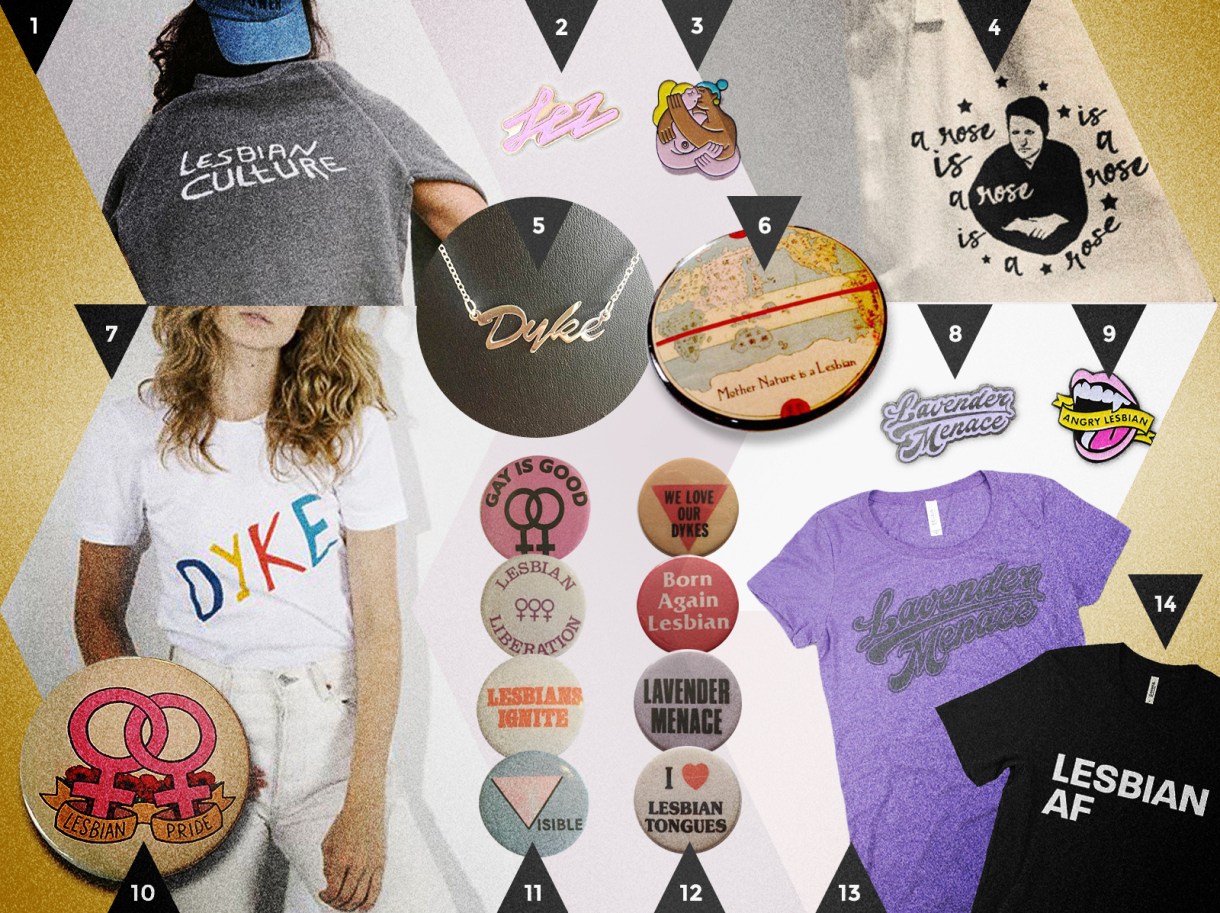
1. Lesbian Culture Sweatshirt (Otherwild) ($60), 2. Lez Pin ($10), 3. Lesbian Kissing Pin ($10), 4. Stocking Stuffers Gertrude Stein Tote Bag Feminist Tote ($29.99), 5. 16″ Dyke Necklace ($25), 6. Mother Nature Is A Lesbian ($2.25), 7. Dyke T-Shirt (Otherwild) ($36), 8. Lavender Menace Pin ($10), 9. Angry Lesbian Pin ($10), 10. Pack of Four Vintage Lesbian Pride Badges ($5.41), 11 & 12. Lesbian Pride Buttons ($2.50), 13. Lavender Menace T-Shirt ($25), 14. Lesbian AF T-Shirt ($27.69)
Just dyke out.
For Your Lesbian House

1. Feminism Encourages Women to Leave Their Husbands, Kill Their Children, Practice Witchcraft, Destroy Capitalism & Become Lesbians ($33.84), 2. DYKE Is Out: Are You? Poster – Museum of the City of New York – ($27.50), 3. Lesbian Journal (Otherwild) ($11), 4. Lipstick Lesbian Hand Embroidered Art Hoop ($15)


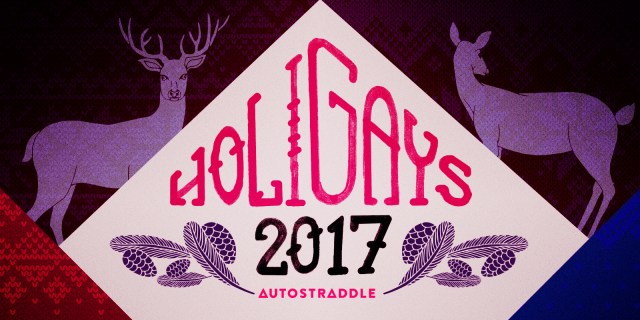

OH NO I WANT ALL OF THESE THINGS
i think the kids say “just @ me next time”?
this makes me feel alive
I feel like I have a lot of reading to do to become a renaissance lesbian!
i believe in u sally
so much good stuff here! that lavender menace shirt is coming to my wardrobe soon.
there’s also some really good, thoughtful critiques out there of sarah schulman’s book that y’all might like to read. i haven’t read the book itself (thanks depression and poor attention span!) but have found critical voices with some persuasive and damning words here (http://umruik.tumblr.com/post/149050012552/not-a-eulogy) and elsewhere. as always, people should read for themselves and make up their own minds.
yeah, i’ve read that and also looked into what she’s referencing and what others have said and written about it, extensively, and my mind remains where it is. i don’t think that post is a really fair representation of the situation but! that’s not really a convo for a gift guide, so.
That sign is inaccurate. You don’t have to practice witchcraft.
I know some haunted dolls who may disagree with you…
I enjoy the merch and the history behind it!
I tried to Google what is meant by “woman-identified woman” from that era and came up blank. From 2017, it would seem to be a reference to trans women being women, but from the 1970’s era info and document, it seem to refer to some other meaning that I can’t determine. Anyone know?
I do! The term “woman-identified woman” isn’t about transness, but about lesbians.
To the authors, many women are not “woman-identified” because they have close relationships with men that often cause them to identify their interests with those of men, even at the expense of their own. A contemporary example would be 64% of white women voters in Alabama.
However, a woman can be “woman-identified” if she instead chooses to place a primary value on identifying with and supporting the interests of other women.
To me, this sounds like a cool and interesting idea. IMO it then veers off into bonkers territory by saying that ANY woman who primarily values women is a lesbian. This led to a lot of earnest straight women who didn’t like patriarchy trying to be lesbians, and that didn’t work so well, but it was an interesting experiment.
oh thanks for the interesting and well-written explanation!
“This led to a lot of earnest straight women who didn’t like patriarchy trying to be lesbians, and that didn’t work so well, but it was an interesting experiment.”
Yes, this is one of the most fascinating elements of that period of history that I love talking to older lesbians about! The like, truly believing that feminism is the theory, lesbianism is the practice. Which I think played into the idea of lesbians as ‘sexless’ because a lot of them were because they weren’t actually gay so they didn’t want to have sex. I’ve read a lot of stuff from back then that is like, lesbians don’t have to be hypersexual like straight people and gay men, we’re different. which is then where a lot of conflict with sex-positive feminist lesbians arose too.
But honestly a lot of the ideas behind it are pretty great, I can’t say I don’t see the appeal.
This was a very interesting discussion. Thank you all for sharing.
AS Hands down the best comment session on the whole English speaking Internet
It seems like there is a less codified contemporary version of political lesbianism, wherein straightish people put on a queer identity for political purposes. I have known several women who felt like they should sleep with other women not because they actually desired them but because they thought it would make them ‘more feminist’. That’s not how this ought to work!
In the 1970’s “woman-identified woman” meant Lesbian.
Does Autostraddle have a goodreads account? If it does, could it make a cool feminist history reading list that I could follow obsessively?
we don’t! i do though. we did do a feminist reading list 101 in 2010 but i don’t think we knew as much about the topic then as we thought we did. looking over it now i’m like hmmm. and definitely i didn’t know enough about lesbian feminism yet.
I’m bisexual (womp womp) but for some reason, this is 100% up my alley?
BC IT’S UR ALLEY TOO
this is so 100% up my angry well-read lesbian alley, thank you autostraddle. i’m linking anyone to this when they ask what i want for christmas.
the rest of the gift guides have been on point to — i’ve got stuff for everyone on my list now!
When I saw this gift guide I yelled “YES” because this describes my girlfriend VERY well, but only on the inside because she’s sitting next to me on the couch and I don’t want to give the game away.
(On another note, I love the Lavender Menace tees but thought maybe I shouldn’t get one for myself because I’ve identified as bi for years (and more recently nomasexual), and also as a demigirl for about a year so far, and I didn’t want to co-opt anything, so the bit about “lesbians, queers, bisexuals, pansexuals and otherwise-identified women and non-binary people who look good in purple” made me feel better, so as soon as it’s a good idea for me to buy myself t-shirts again, I will be getting one!)
I love my Lavender Menace shirt, it’s so soft and cuddly
i have three and they’re all so soft and cuddly
The “Dyke is out” poster seems to be sold out at that link! I found another similar poster here: https://www.smallequals.com/listing/479226479/dyke-is-out-lesbian-art-lesbian
Thank you for catching this. It is the same poster, which I designed. Some were at the Museum of The City of NY. Possibly they sold out, I don’t know. They didn’t tell me. But I have a few for sale at my online shop http://www.smallequals.com
Ignore my last comment. The poster shown shown in the list, above, which is titled “dyke is out” is actually the framed print of the cover of DYKE A Quarterly from 1976, featuring a photo by 19th Century Lesbian photographer Alice Austen. It is available at my shop http://www.smallequals.com. I designed the cover and sell the print. The DYKE IS OUT, ARE YOU? is a different image, also made for DYKE A Quarterly. This is the one that was at The Museum Of The City of NY. I don’t know if it’s still available there, but I have it in my shop. Both images ©Liza Cowan
Does “A Burst of Light” have any essays or writings that aren’t in Sister Outsider or Zami? If so, how many?
Emily Hobson (author of Lavender and Red) is one of my favorite professors (also my thesis advisor)! She does such amazing and important research it’s so exciting to see her book on this list!!
Not gonna lie, I just ordered that book for myself because it looks awesome